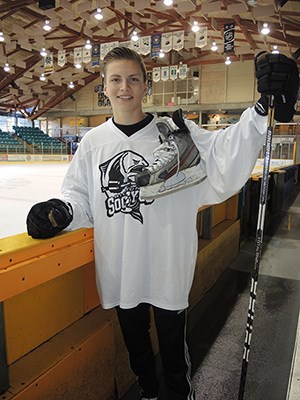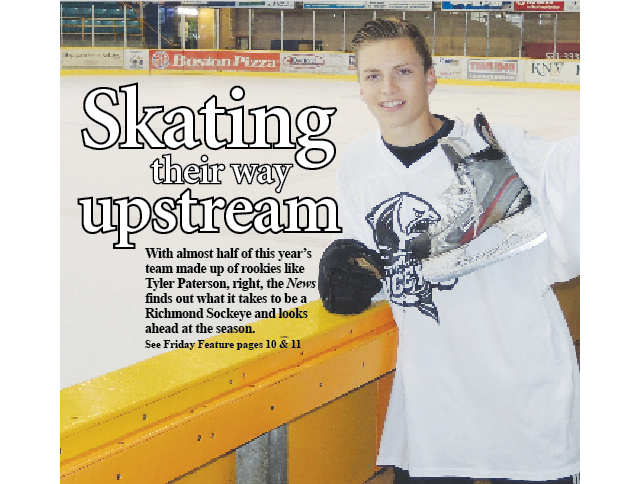Becoming a Richmond Sockeye is not an easy task. With thousands of youth playing ice hockey in each age division throughout Metro Vancouver the competition is stiff. In fact, it’s only getting more competitive as the years pass by, pressures mount and big league dreams become glitzier.
Getting that extra edge on the ice has resulted in special measures taken by parents, with hockey academies starting to pluck elite players away from traditional minor hockey organizations.
Tyler Paterson is 17 years old and heading into Grade 12. The well-spoken young man, currently trying out with the Surrey Eagles, will be one of the newest Sockeyes as he embarks on his rookie campaign, potentially along with up to 11 other rookies at a club that’s undergoing a rebuild following a near championship run.
“Jumping up to a junior level, obviously the guys are bigger, but I’m excited to get into the mix,” said Paterson, from his home in White Rock.
Paterson, the nephew of Sockeyes co-owner Doug Paterson, already has an impressive pedigree having played in an elite, up and coming varsity-style high school hockey league, the Canadian Sport School Hockey League (CSSHL), which formed in 2009 and now consists of 11 academies as far away as Alberta and Idaho.
The league is considering adding another five teams, according to BCHockeyHub.ca, with a proposed North Shore academy asking $13,500 per player, including travel, for the season.
During the last two years, Paterson, a winger, played for the Delta Hockey Academy where practice ice time was about three times that of minor hockey and coaching was more in-depth. He trained nearly every day and was on the ice nearly every other day.
The hockey academy is linked to South Delta secondary to provide academic support for the players. Paterson used to leave school midday to practise but gained course credits for his absence (the academy is considered the equivalent of a typical physical education class). Time spent travelling was usually time spent studying, Paterson said.
“They make sure you button down on homework and get good grades,” he said.
Sockeyes head coach Judd Lambert says more elite training such as what these academies offer is needed in Canada to stay competitive with the United States.
“It might sound harsh, but that’s the reality in the U.S. It’s interesting to watch. I don’t know if it will, one day, take over entirely,” said Lambert.
It’s all very hard work for a young person, but Paterson said he enjoyed every minute of it.
“I loved it. It was a really good experience. Development was unreal. The days were long, waking up at 6 a.m. and getting home at 4 p.m. But, at end of day, you’re not complaining, and your game goes to a whole other level,” explained Paterson.

The hard work paid off and Paterson will don number 42 on the back of his floppy, silver fish jersey at Minoru Arenas.
The ethic instilled in him at the academy will help him prepare for the more rigorous standards of the Junior B Sockeyes, where he’ll meet 19 and 20-year-old teammates and more will be asked of him.
“It’s much better organized. There’s the whole camp situation in the summer, you’ve got your own dressing room and can leave stuff in there,” said Paterson.
When it comes to academics, Sockeyes general manager Richard Petrowsky said there’s little room for failure.
“We’re very high on that. …We tell them if you have some major studying to do and they come up to us and say they need to study, it’s not an issue,” said Petrowsky.
That said, players can’t be skipping practices often, he noted. Furthermore, the Sockeyes practise at night, unlike other clubs, as to not force students to miss classes.
Number 42 will also have a greater on-ice and off-ice support network.
For starters, league fees to play in the Pacific Junior Hockey League are only, on average, about $2,500, depending on the club, said Petrowsky.
Furthermore, most of his pads will be paid for and the Sockeyes have professional trainers, who can better handle injuries. Take concussions for instance, a rising epidemic in the game.
“The kids are assessed for concussions before the season. …Any head shot and they go into the dressing room to be tested,” said Petrowsky.
Also, because the Sockeyes webcast their games, video coaching is available, when needed.
“Now we have video and can watch ourselves,” said Paterson.
Paterson will also have to develop into a community role model as the Sockeyes often participate in public events, such as reading to elementary school children.
If Paterson excels, he could be looking to the Junior A system next year on a tryout basis; the Sockeyes are renowned for their development of young, blossoming players.
But for now, he’s focused on keeping the ship steered in the right direction after an exodus of veterans.
“We have a really young team and that’s what I’m excited about,” he said.
“There are a lot of good players and there’s still a good foundation from last year.”
2014-2015 Season preview: Young fish getting ready to jump
The crisp September air and dew on the grass signal many things in Richmond, namely going back to school (usually) and, of course, ice hockey season.
This year the always reliable Richmond Sockeyes embark on their 42nd season overall and 25th campaign in the Pacific Junior Hockey League.
This weekend marks the wrap-up to training camp at Minoru Arenas as the exhibition season gets underway in preparation for Thursday’s home and season opener against the Grandview Steelers.
And with a young squad consisting of 12 rookies, this season will prove to be one of many unknowns.
“We’re in a rebuild mode right now, we don’t have many returning players,” noted Sockeyes general manager Richard Petrowsky.
While this may prove difficult on the ice in the near-term, it also means few will be bothered by any remnants of the club’s devastating game seven loss against the Aldergrove Kodiaks in the championship finals on home ice.
“We don’t really know what to expect. We haven’t seen the other teams. So, we don’t know if we’ll get the same results. We’re young , there are lots of rookies and it’ll be an interesting year,” said head coach Judd Lambert.
The Sockeyes are looking to create the next crop of young men who will hope to repeat the 2013 season whereby the team amassed three championship trophies, including the Keystone Cup for Western Canada’s top Junior B team.
Even getting close to last year’s relative success, when the club won the regular season title with a stunning 34-5-3-2 record, would be an impressive feat.
But the road for these young fish will prove arduous.
The exodus of players includes the team’s top three scorers: John Wesley, last year’s rookie of the year is expected to play for the Vancouver Giants of the Western Hockey League (Major Junior), Liam Lawson for the Powell River Kings of the Junior A British Columbia Hockey League, and Ayden MacDonald for the Vernon Vipers, also of the BCHL. Combined, the three scored 73 goals and added 70 assists in the 44-game season.
Adding to the departures is Cole Plotnikoff who tallied 25 points in 43 games, but is now slated to play for the West Kelowna Warriors.
This year, according to Petrowsky, it’s also highly unlikely the Sockeyes will see the return of Richmond resident Jacob Wozney who is short-listed to make the Nanaimo Clippers of the BCHL. The playmaking Wozney was fifth in team scoring among forwards.
“Certainly, those players were good. They had potential and played up to it. They got what they deserved,” said Petrowsky.
Also not returning are stalwart veteran defensemen Adam Nishi and Dominic Centis, both of whom are now too old for junior hockey and have since hung up their competitive skates.
After getting through the exhausting list of who isn’t playing, it leaves Mac Colasimone, Matthew Bissett and Daniel Oakley as the top-three veteran forwards who are coming back.
Those three will be joined by Richmond resident Troy Kaczynski, a 20 year-old who has bounced around the Sockeyes organization for a few years but has never found a way to stick.
This year, according to Lambert, should be different for the hometown kid.
“We expect him to be one of the dominant players in the league this year,” said Lambert, touting Kaczynski’s size and speed as his dominant features.
Both Petrowsky and Lambert concur, despite the exodus up front, that the forward core should be sustainable enough to produce offense and, hopefully, wins. But with Nishi and Centis’ departure the defence will be a work in progress. Although the blueline will be anchored by veterans Trevor Lima and Jordan Andrews.
The last defence — that is to say, goaltending — will be a competitive position for the Sockeyes this year and how it plays out will be interesting for fans.
The club currently has three keepers on the roster and will eventually pare that down to two. Lambert said there is no frontrunner and called the position a “toss up.”
Kurt Russell is the only returning goalie. He posted a 9-2-1-0 record with a 2.64 GAA as the team’s backup to Kootenay Adler, the league’s best goaltender in 2013-14.
Russell will vie for the starting role alongside Nathan Alalouf and Adam Cronier, a Richmond resident.
Alalouf spent last year bouncing around Junior A teams and had a cup of coffee with the Saskatoon Blades of the WHL. The Sockeyes recently acquired him this summer.
“We’ll pick the best two guys and it might take a while to decide that,” said Lambert.
All in all the Sockeyes are currently listing 12 rookies on the active roster, which stands at 25 players. That may decline over the year when rosters are reduced and players are shuffled between Junior A and minor hockey and/or major midget leagues.
As for how to deal with such a young team Lambert said only minor adjustments are needed.
“The principles remain the same but you have to make adjustments to collective and individual strengths,” said Lambert.
“We don’t stifle creativity, but we have to all be on the same page. Ultimately, that showcases players better because the team is playing better,” noted Lambert.



